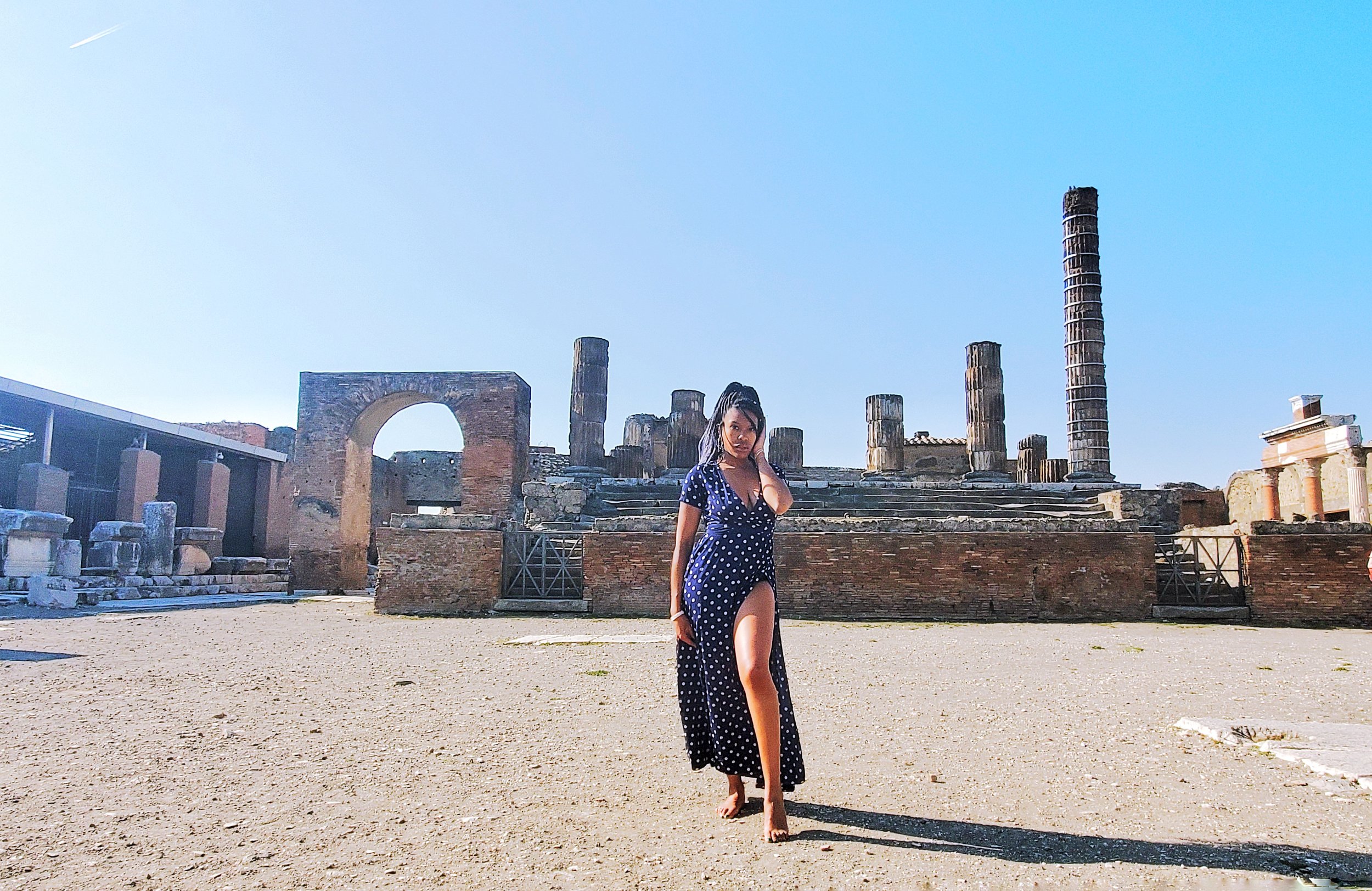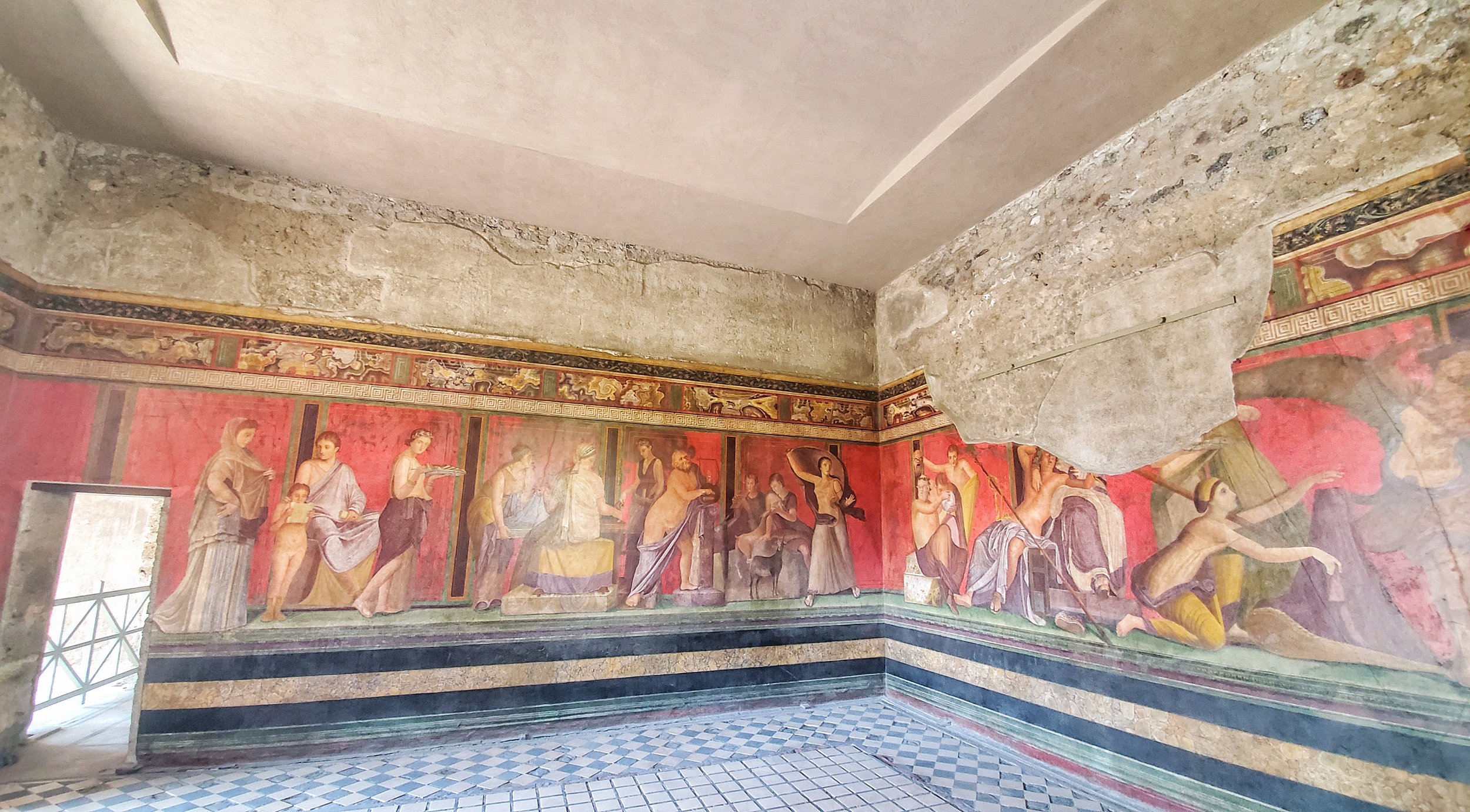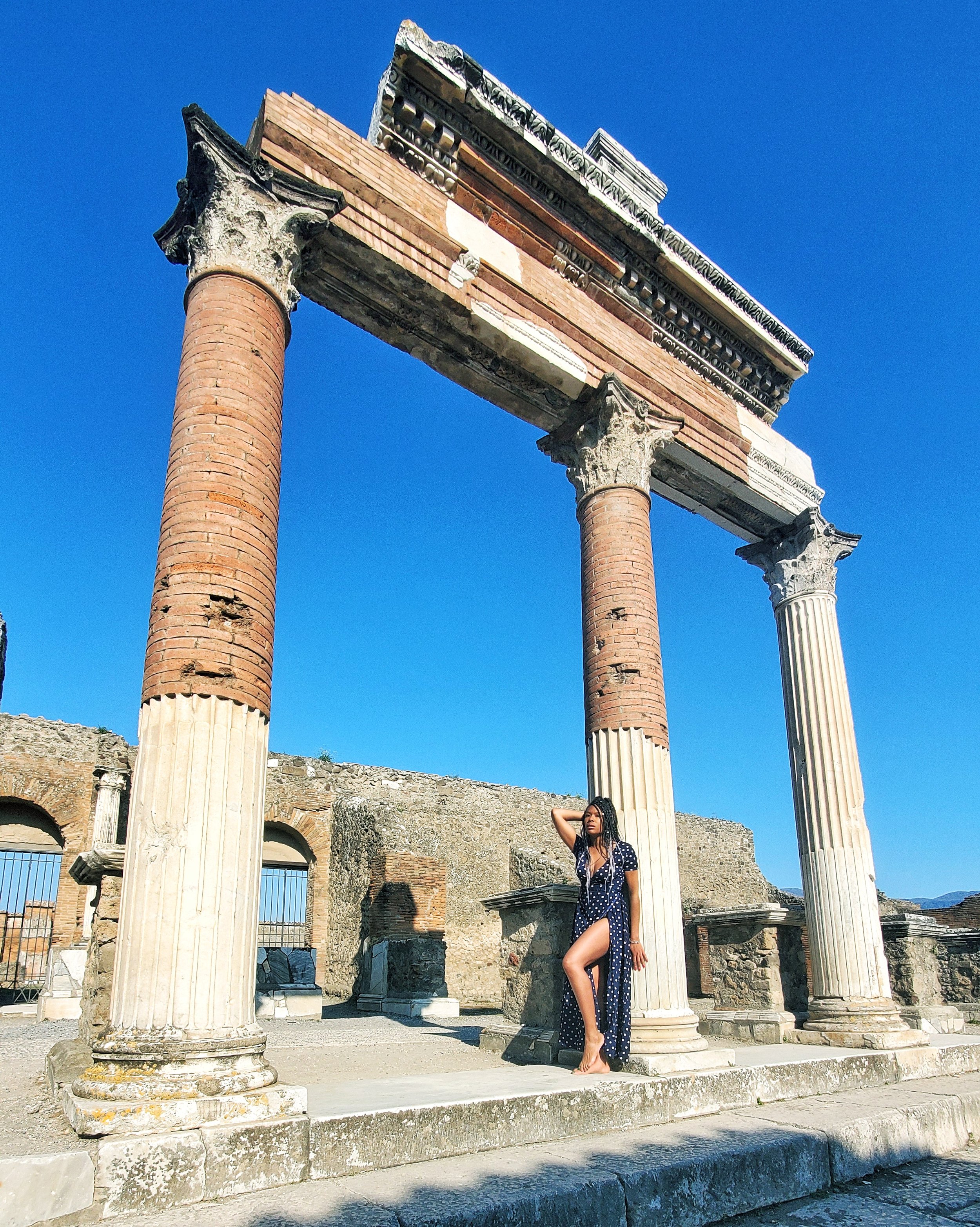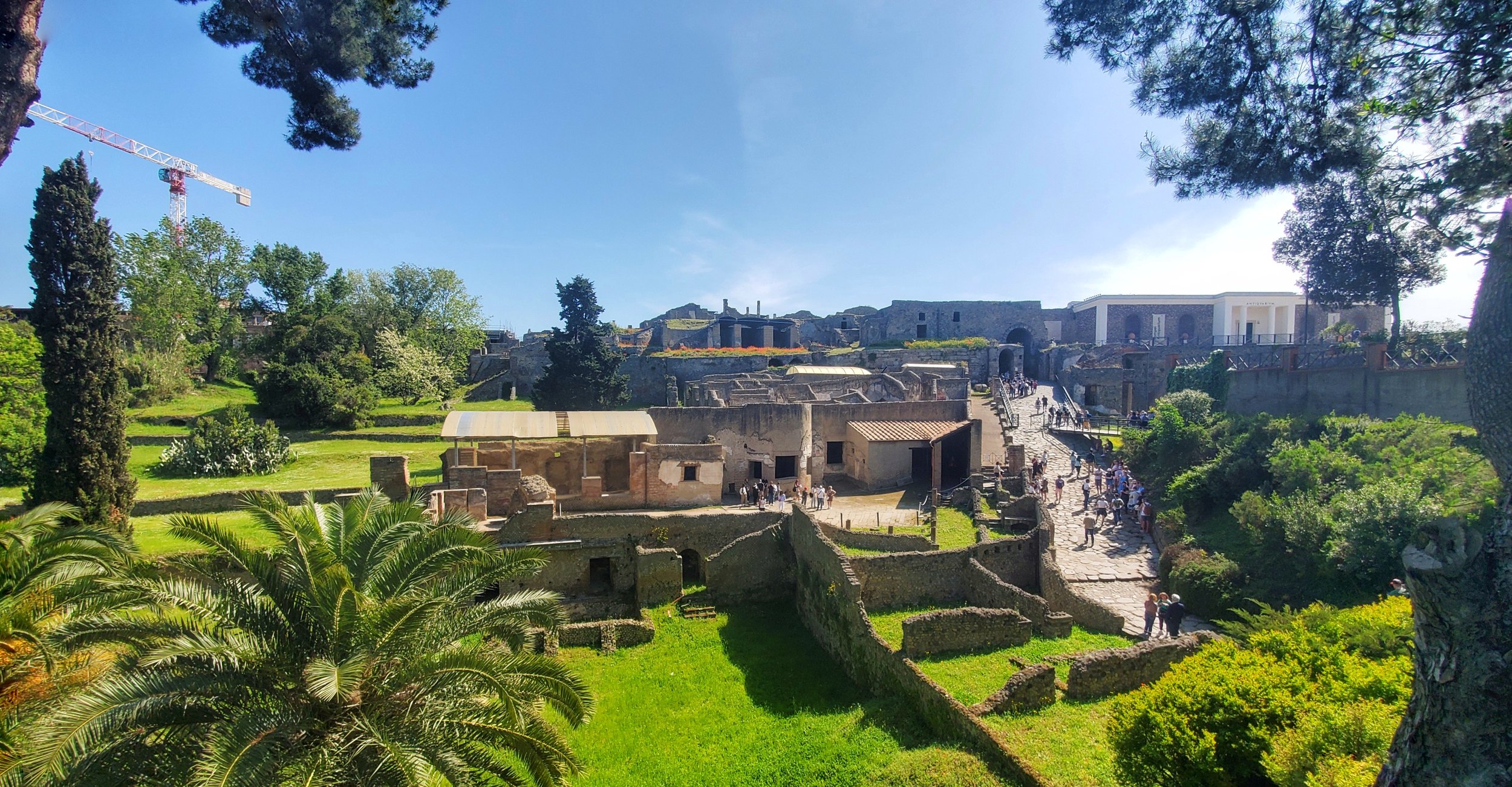In the shadow of Mount Vesuvius lie the ruins of Pompeii, an ancient city buried when the volcano violently erupted in 79 AD. The former Roman civilization would be lost for the next several centuries, with its inhabitants frozen in time under waves of lava and ash until the site was eventually unearthed close to Naples in southern Italy. Despite excavations by archeologists, only two-thirds of Pompeii have been rediscovered so far yet the ruins are thankfully open to visitors.
If you’re in Naples and want to know the best things to do in Pompeii and how to get there, this article is just for you! Located merely 26 kilometers from Naples, the UNESCO World Heritage Site is easy to reach via public transportation and filled with lots to see and uncover. Spanning 44 hectares, Pompeii is an enormous archeological site that merits at least a full-day trip to do right, however, certain exhibits are only open on specific days so travelers should plan their visit accordingly.
Frolicking around the Forum…
Ready to roam around the ancient ruins of Pompeii and uncover its secrets? Just make sure to wear some decent walking shoes. Andiamo!
The Legend of Pompeii
Pompeii was originally settled in the 8th century BC by the Oscans from central Italy. They established five villages and the growing town would derive its name from the Oscan for the number. The area would fall under Roman rule by the 1st century BC, becoming a haven for wealthy tourists, the tradesmen who serviced them and the farmers who fed them thanks to its rich lands and position along the Bay of Naples. Like many tourist destinations, the thriving resort town was home to plenty of attractions, such as an amphitheater, artisanal shops, bathhouses, and brothels; everything a Roman citizen could ever need for a relaxing getaway.
Nonetheless, Pompeii’s prosperity wouldn’t last for much longer as a series of earthquakes began to shake up the inhabitants’ way of life. A massive earthquake in 62 AD destroyed much of the settlement and caused copious casualties, a terrifying herald of what was to come nearly two decades later. By 79 AD, the popular town had a permanent population of nearly twenty thousand people, many of whom would not survive the coming onslaught. The dire circumstances would only be compounded by the fact that the town was hosting two multi-day festivals that had also attracted many more merchants, performers and tourists alike. Even worse was that one of these festivals was to celebrate Volcan, the god of fire and volcanoes, so as Mount Vesuvius began to rumble, many onlookers took this as a good omen from the deity.
The coming eruption of the 1800-meter-tall Mount Vesuvius was thus proceeded by many days of seismic activity that rocked the region. Still, this behavior wasn’t entirely uncommon since Vesuvius had erupted at least fifty times since its formation millions of years beforehand. The cities around the active volcano had kept on increasing in size despite the apparent danger and in 79 AD the fish in the nearby Sarno River unexpectedly began to die (now known as a result of the acidity of the water), another omen of what was to come.
Fearing the end of the world, several inhabitants fled from the ominous rumblings but many stayed, confused as to the nature of the strange phenomena as ash began to fall from the sky like snow. While the neverending gray flakes started to blanket the surrounding area, the temperature also began to rise, reaching upwards of 300ºC. The initial victims of the first powerful blast might have been the most fortunate since they were instantly killed by the roar of suffocating soot and poisonous smog. Other victims weren’t so lucky as they were buried alive by molten falling debris, only succumbing once crushed into oblivion as the eruption persisted and layers of volcanic matter rained down for the next two days.
Pompeii wasn’t the only civilization devastated by the eruption which also buried the nearby communities of Herculaneum, Torre Annunziata and Stabiae. The force of the blast was also witnessed for kilometers around, spurring other neighboring coastal hamlets to undertake rescue attempts by boat, only to be dissuaded by large chunks of spewing rocks and boiling waters as lava fell into the sea. The apocalyptic disaster was further compounded by the scorching pyroclastic flow that soon followed, which choked the air and left no more survivors, killing an estimated two thousand people. The next morning, the cone of the volcano would collapse, sending an avalanche of earth for several kilometers and these poor souls were doomed to spend the next 1700 years buried under 10 meters of ash and dirt.
In the end, most were fortunate to escape in time, merely to become refugees as they scattered across the Roman empire in search of new homes. The Roman emperor at the time, Emperor Titus, would fund cities that accepted refugees, but never again would there be a Roman colony at the base of the mountain. However, neither was the site lost to time as over the next centuries Romans then looted the ruins for valuable remnants, a practice that endured into the 19th century as excavators plundered Pompeii for relics.
Fortunately, the responsibility for the site fell to one archeologist, Giuseppe Fiorelli, whose innovations lead to the site being painstakingly unburied and preserved. He was also the mind behind Pompeii’s notorious plaster models, with the material used to fill the holes left by the bodies of victims and recapture their final, agonizing moments. These days, you can relive the harrowing experience for yourself since, in the outcome of the disaster, Pompeii has once again become a well-known tourist destination, open to the public year-round.
How to Get to Pompeii
Pompeii is located a mere 26 kilometers away from Naples with Mount Vesuvius serving as the backdrop and a looming reminder of the destruction it had once wrought. The journey from central Naples takes only roughly 30-40 minutes by public transportation, the first stop of which includes catching a train from Napoli Piazza Garibaldi Station (within Napoli Centrale Station) or a bus from SITA Bus Station. Instead of purchasing round-trip fare, you can also opt to get a day pass which will grant you 24-hour access to local buses, metro lines, and low- and medium-speed trains (useful if you plan to visit more than just Pompeii).
PRO TIP #1: Cash is king in Naples so make sure to bring enough to get yourself to Pompeii and back (10€ should be more than enough).
By Train
You have two train options from Naples to Pompeii, with the most popular being the EAV Circumvesuviana, a public train that passes through the suburbs scattered around the Gulf of Naples. The Circumvesuviana train is about a 35-minute trip whereas your other option, the Metropolitano train, covers the same distance in around 38 minutes.
Both train lines offer around-the-clock departures, sometimes twice per hour, with the first trains leaving from Naples to Pompeii around 6 AM and returning trains from Pompeii to Naples ending around 10 PM (just make sure to consult relevant timetables as they are frequently subject to changes).
Better still, for both options, the tickets are generally cheap. Although, to be fair, not one conductor checked our tickets to and from Pompeii (I don’t encourage train-hopping and your ticket can make for a cool souvenir in any case).
The EAV Circumvesuviana Train
Make your way to Napoli Centrale Station which also houses the separate Napoli Piazza Garibaldi Station within. Follow the blue signs leading toward Circumvesuvianai, then head downstairs to a covered walkway and then to Napoli Piazza Garibaldi’s ticket office (around a 5-minute walk). Tickets are available from any of the automatic ticket machines in the train station or from any ticket agent.
Nevertheless, keep in mind that Pompeii is a popular destination and ticket queues can get incredibly long during high season so I highly recommend buying your tickets a day or two before and then just strolling right to the boarding platform on the day of your adventure. Advanced seat reservations are not possible so your only option for this route is to buy your tickets in person so make sure to arrive early to snag yourself a comfy spot.
PRO TIP #2: If you must take the Circumvesuviana train, catch it from Napoli Porta Nolana Station, which is just one stop before Napoli Piazza Garibaldi Station and, thus, much less crammed with tourists.
You should obtain tickets for the blue ‘Sorrento’ line heading toward Pompei Scavi and, once you’ve secured your passage, go past the barriers to head downstairs to the platform area and get on a train with ‘Sorrento’ marked as the final destination. After about a half hour, get off at Pompei Scavi/Villa dei Misteri Station and you’ll find the entrance to the ruins just a few minutes away.
PRO TIP #3: Pompei Scavi/Villa dei Misteri Station provides storage for travelers with luggage, as baggage won’t be allowed in the ruins otherwise. This might be the best option if you’re planning on staying in Pompei overnight.
The Metropolitan Line
While the Circumvesuviana train is certainly the road more traveled, the Metropolitano train is still a great choice and, despite running a wee bit slower, also has a few more perks than its competitor. For instance, since this line is operated by Trenitalia, you can buy your tickets in advance on online. Another big difference between the lines is that the Circumvesuviana is usually much more overcrowded while lacking any air-conditioning since the metro cars are much older. The Metropolitano, on the other hand, is air-conditioned, more spacious and, therefore, generally less packed.
The main drawback of the Metropolitano route is that you’ll have to exit the train at Pompei Station, which is about a 10-minute walk from the ruins of Pompeii. Travelers arriving with the Circumvesuviana will be let off closer to the entrance but if you don’t mind the scenic stroll through the town of Pompei (note the difference in spelling), this is the best option for those looking for comfort over speed. You can catch the train from Napoli Piazza Garibaldi Train Station to arrive at your destination within the hour.
By Bus
For travelers on a budget, there’s no cheaper option than catching the bus to Pompeii, especially since the bus voyage takes about the same time as the train (35-40 minutes). Running from around 7 AM to 8 PM, the buses leave just as frequently, nearly every half-hour or every hour, depending on the weekday. Most of these routes are operated by the local SITA buses but Flixbus, which is a smidgeon pricier, also manages a few, offering buses that are not only more comfortable and spacious but also air-conditioned.
PRO TIP #4: The bus is the best option for travelers staying near Naple’s cruise terminal at Nuovo Marina since they tend to run more frequently than trains.
To catch the bus, go to the SITA ticket office at the Nuova Marina Port to buy your tickets first and then head to the SITA Bus Station, just a stone’s throw away. Make sure to purchase tickets for the Napoli-Salerno route but not every bus stops at Pompeii so double-check with your driver just in case. You can even buy your tickets directly on board but the occupancy limit might be subject to demand during high season.
No matter which bus company you choose, any bus will take you along at various stops around the ruins but the closest stop to the entrance is the Pompei Scavi Bus Stop (usually the third or fourth stop). Simply walk a few minutes to the ruins and you’ll swiftly arrive at your destination.
By Car
Hiring a car while in Naples is the best way to explore the region’s top sites for visitors traveling in large groups. Covering 28 kilometers, the drive between Naples and Pompeii only lasts about 30 minutes, and navigating the route is easy since it’s a direct shot on the A3 highway.
However, there are a few tollbooths on this route so make sure to bring cash (in euros) to pay the toll. Exit at Pompeii Ovest, which will lead you straight to the ruins and where you should find ample parking lots, even during high season. Still, once you park, you’ll need to catch a shuttle bus from the parking area to the ruins themselves (or walk the distance).
On your way from Naples to Pompeii, you could also stop by Mount Vesuvius, which lies between the two, but just keep in mind that the journey is much longer, around 75 minutes (around 50 kilometers).
Another thing that foreign drivers must keep in mind is that traffic in Naples is known for being chaotic (let’s not even mention trying to cross a street on foot) so there is an added sense of danger for the uninitiated. Make sure that your car insurance covers every form of accident and stay on high alert the entire way because, while you might be a safe driver, it’ll be everyone else you’ll have to worry about.
Top Attractions in Pompeii
Pompeii has three main entrances, Porta Marina to the southwest, followed by Piazza Esedra a bit further east, and then finally Piazza Anfiteatro to the southeast. Covering a surface of 44 hectares, the archeological site is enormous, with many of the sites located to the southwest of the area (check the map below for reference). While a guided tour is a must to get the best historical context, most 2-hour tours will only cover about the tiniest fraction of Pompeii. Walking around afterward is definitely recommended as there are so many artifacts, monuments, and viewpoints still to uncover (in total we spent nearly six hours exploring the site) Via dell’Abbondanza once acted as Pompeii’s Main Street.
The archeological site also has a few modern facilities such as toilets near the entrances and water fountains throughout, as well as a grilling area (all mostly toward the southwest). You can also buy souvenirs or gifts from the bookshops located at the Piazza Esedra and Piazza Anfiteatro entrances. The medical service facilities are due north of the Piazza Esedra entrance, just past the Foro.
Popular Landmarks
While there are over fifty landmarks noted on Pompeii’s official map, some of them definitely can’t be missed, even by travelers with limited time or capacity to walk around. The total amount of sites is extensive so this list will only detail the best ones to see first. Since you have your choice of entrances, starting from the west entrance grants you direct access to more sites but this also tends to be more crammed with tourists. Alternatively, if you begin from the east, you can go directly to one of the biggest attractions, the Anfiteatro.
Anfiteatro (Amphitheatre)
Pompeii’s Anfiteatro has many claims to fame; it’s the world’s oldest surviving Roman amphitheater and also the first one to be made of stone (previously they had been built with wood). It’s even older than the Colosseum in Rome by over a century, erected in the 1st century BC in a sparsely populated area of the community so visiting spectators wouldn’t disrupt daily life.
Featuring an elliptical shape, the structure is 135 meters long, 104 meters wide and 6 meters deep with enough space to have once held around twenty thousand spectators. They could enjoy everything from wrestling matches to men fighting beasts, rain or shine, as the venue also included a fabric tarp that covered it completely when necessary. Spectators could also watch gladiator games, which lasted between 3-5 days, and comprised of sometimes as many as three dozen fighters. The easiest way to make it to the Anfiteatro is by entering through Pompeii’s Piazza Anfiteatro entrance (hence the name).
FUN FACT: In 1972, Pink Floyd played a concert in Pompeii to an audience of none but the recorded footage was later released as part of a documentary.
Teatro Grande (Greater Theatre)
Lying between the west- and east-most entrances, the Teatro Grande was first built by the Samnites (ancient Italic peoples), featuring Hellenistic Greek characteristics with its hillside position and panoramic views of the Sarno Valley and Lattari Mountains. The open-air theatre was later reconstructed and enlargened in the 2nd century BC before going under subsequent renovations by the Romans during the next few centuries before its burial in 79 AD. The Teatro Grande still retains a horseshoe shape, an ultra-semicircular form that was favored by the Greeks as opposed to the hemi-circle favored by the Romans. Back in its hay day, it could hold up to five thousand spectators ready to watch gladiators fight to the death.
Enter from the Piazza Esedra entrance to head there first and try to take in the view before the crowds set in. Nearby you can also find the Tempio Dorico (Doric Temple, another common Greek fixture) and the Teatro Piccolo-Odeion (Odeon Theatre, a smaller theatre that was popular for musical performances and poetry recitals). The Teatro Grande is generally open from 9 AM to 7 PM.
Tempio di Apollo (Temple of Apollo)
One of the oldest remaining monuments in Pompeii, the Tempio di Apollo is also one of the most visited, and for good reason. The temple was once the most important religious building in the city, with the first altars dedicated to Apollo dating back to the 8th century BC. The first building was erected in the 6th century BC by the Samnites, soon spawning a large following as Apollo became the most revered deity in Pompeii. The Greek god of the sun’s popularity would eventually wane when the Tempio di Giove was built and more followers instead began worshipping Jupiter (Apollo’s father). Both temples are located off of the Foro, which is home to several other notable sites.
Foro (Forum)
The Foro was the former main square of Pompeii and its center for culture, politics, religion and economics, often used for any manner of public events by the Romans. It was originally constructed in the 4th century BC by the Samnites when it functioned as a communication hub with roads connecting to other closeby communities such as Stabia and Neapolis. Under Roman rule, the square was remodeled and enlargened in the 2nd century BC, leading to the removal of the shops and a wall shared with the Tempio di Apollo.
Instead, religious and political buildings were erected along the perimeter of the main square, particularly around the turn of the century when the paving was redone and the portico was added. There are a plethora of monuments surrounding the 143-meter-by-38-meter Foro so take advantage by also making stops by the Basilica, the Tempio di Giove (Temple of Jupiter, built in the 3rd-century BC), the Macellum (fish and meat market), and the Tempio di Apollo.
Basilica
Built in the 2nd century BC, the Basilica was the main administrative building in Pompeii and one of the largest, initially stretching over 1500 square meters. Its sides were adorned by 28 brick columns, spanning 11 meters high, and, within its majestic halls, it housed spaces to conduct commercial trading along with serving other economic and political purposes. The massive complex also contained Pompeii’s law courts, where all legal cases were overseen by the local magistrate.
Apart from the Basilica’s administrative functions, it was also a popular communication hub, frequented by many as evidenced by the vulgar graffiti that can be found scratched onto its walls. In its glory day, however, the building was magnificently decorated and its immense stature dominated the Foro, next to which it is situated.
Villa dei Misteri
If you don’t have much time to see anything else in Pompeii, at least try to swing by the secluded Villa dei Misteri (Villa of the Mysteries). Although located quite a way away from the rest of the other sites in the northwest corner of the ruins, the villa is worth stopping by for its decor alone. As one of the best-preserved sites in Pompeii, the suburban estate is famous for its fantastical frescoes (some of the rarest ancient Roman paintings in the world), which depict the initiation of a woman into a Dionysian mystery cult (not to be confused with the cults of Jupiter or his son, Apollo).
Once lying by an ancient shoreline, the villa is built in the 2nd century BC on a hillside that offers sweeping views of the modern-day Gulf of Naples. Like many other monuments in Pompeii, it was enlargened during the rule of Augustus near the turn of the century but fell into disrepair after the earthquake in 62 AD. It was eventually rebuilt and repurposed but, also like many other homes in the archeological site, ownership of the villa is widely debated, with some attributing it to Livia (Augustus’ wife) or a freedman from a powerful family. In any case, it was one of the first sites to be excavated once Pompeii began being rebirthed like a phoenix from the ashes left in the wake of Mount Vesuvius’ eruption.
The villa was mostly intact despite the firestorm it had survived centuries earlier, leading to the discovery of several bodies inside. Three were buried under layers of lower pumice from the eruption’s initial stages, meaning they’d passed at the start of the catastrophe, while another six were discovered in the pyroclastic layers, indicating that they’d succumbed just as the town was completely blanketed in death. A collapsed roof would have made any escape attempts futile and the holes left in the layers by their decomposed remains were filled with plaster to form casts that are visible throughout Pompeii.
Plaster Casts
From the mid-1800s onwards, plaster casts were made of the victims of the fall of Pompeii as more and more excavations went underway and two-thirds of the ruins were unearthed. While the vast majority of inhabitants managed to escape with their lives, over a thousand bodies were uncovered. Most victims were found in the Garden of Fugitives, a fruit orchard (13 in total), with the next runner-up being the Villa of the Mysteries (9).
The majority of these were later stored in the Antiquarium but the building was heavily bombed by the Allied Forces in 1943 and closed for renovations in 1978. Keep in mind that humans weren’t the only occupants of Pompeii at the time of its downfall and several animal remains were also cast into plaster, with one of the most well-known being that of a writhing dog.
Their dire last moments were recaptured by these powerful pieces so if you don’t mind taking a macabre, closer look at what remains, below is a comprehensive but not complete list of where you can spot the plasters around the archeological site:
Villa of the Mysteries (Villa dei Misteri)
Macellum
Stabian Thermal Baths (Terme Stabiane)
Caupona Pherusa Taven
Olitrium
Horrea
La Casa del Giorno (The House of the Day)
There are copious private residences that were rediscovered when Pompeii was unburied (such as Casa di Octavius Quartio, Casa del Menandro, Casa del Criptoportico, and Casa dei Quattro Stili to name a lavish few) and many are open daily to visitors.
However, the best of the best homes are reserved for specific days, meaning you’ll have to time your visit carefully to access the one you wish to see up close and personal. Below you’ll find a list of every home plus the benefits of prioritizing one over the others.
(A) Casa dell’Ara Massima (Mondays)
The House of the Ara Maxima was excavated in 1903, deriving its name from the fresco of Hercules close to its altar. The small house’s sacrificial altar is decorated by two snakes and it also features another room with a fresco painting displaying Narcissus’ myth.
(B) Casa dell’Ancora (Tuesdays)
Named for the mosaic adorning the floor of its entrance, the House of the Anchor has a unique layout compared to other traditional homes in Pompeii and was excavated during the early 19th century. Apart from a garden, it also features a chapel dedicated to the goddess Venus.
(C) Casa dell’Adone Ferito (Wednesdays)
Dating back to the mid-2nd century BC, the House of Adonis Wounded was once connected to the adjacent property and renovated just before the destruction of Pompeii. This restoration included the frescoed painting of Adonis’ and Aphrodite’s tainted love story in the garden, from which the house gets its name.
(D) Casa della Fontana Piccola (Thursdays)
Excavated around 1826, the House of the Piccola fountain boasts a majestic fountain covered in colorful mosaics and adorned with a bronze statue of Cupid and a fisherman. The side walls around the fountain also feature frescoed paintings of landscapes, which harken back to the once maritime town.
(E) Casa del Porcellino (Fridays)
The House of the Piglet was attributed to C. Sulpicius Rufus, whose seal was found inside, yet it gets its more common name from the painting of a pig’s head in the kitchen. The home was excavated in the 1880s, along with its central garden.
(F) Casa degli Archi (Saturdays)
Featuring arches curved on brick columns, a typical Roman architectural innovation, the House of Arches was excavated in 1954. Each of its rooms is decorated by frescoes paintings, one of which includes a garden to compensate for its lack of green space.
(G) Casa dell’Orso Ferito (Sundays)
The House of the Wounded Bear’s construction dates back to the mid-2nd century AD and is named after the mosaic of a wounded bear located at its entrance. The house boasts some of the best preserved Roman paintings, including the myth of Narcissus, and its courtyard is home to a grand fresco of a garden filled with fauna along with a mosaic fountain depicting Venus and Neptune.
On top of these residences, two more houses require a bit more work to visit, like Casa di Orione and Casa del Giardino, which cost extra to enter. Both are well worth the price of admission for archeology buffs and architecture fanatics.
Final Thoughts
Pompei (the city, not to be confused with Pompeii, the ruins) is a cute little town that’s worth exploring if you have time to there for a night or two. You can also pair your trip to Pompeii with a visit to Mount Vesuvius itself, a nearly two thousand-meter giant that is also mainland Europe-s only active volcano. For both excursions, to Pompeii or Mount Vesuvius, a hired guide is highly recommended so you can get some more historical insight before wandering around on your own.
If you must stay in Naples, try to find accommodation in the Old Town rather than near the train station, as that neighborhood is much more sketchy at night. Also, make sure to watch out for pickpockets if you plan to take the Circumvesuviana line, as there might be a few eager to take advantage of unwitting tourists.
Moreover, the same blue Circumvesuviana line that heads toward Sorrento will also take you to Herculaneum if you exit at Ercolano Scavi Station rather than Pompei Scavi/Villa dei Misteri Station. Herculaneum was another ancient town that suffered a similar fate to Pompeii but was excavated much later which has left the ruins much less packed with tourists than its neighbor and somewhat better preserved. If you want the experience of seeing Mount Vesuvius’ destruction without the hordes of crowds, Herculaneum is your best bet.
While visiting either Pompeii or Herculaneum, be on the lookout for the graffiti often covering the walls throughout the archeological sites (can you guess what the phallic symbols represent?). Even at the turn of the millennium street graffiti was a common occurrence among youths which goes to show that not much has changed over the past two thousand years.
Still, the disaster wrought by the eruption of Mount Vesuvius millennia ago isn’t a distant haunted memory. According to some volcanologists, every year there is more than a fifty percent chance that the volcano could blow any day, a possibility that only increases annually. With over six million inhabitants currently residing in the base of the volcano, the inevitable event would be even more devastating than before. However, many local seismologists are keeping an ear out for any tell-tale rumbles so you don’t have to be worried. Why not visit Pompeii before it might be gone again? Write me when you get there!
May you get lost in the wonder,
M

















